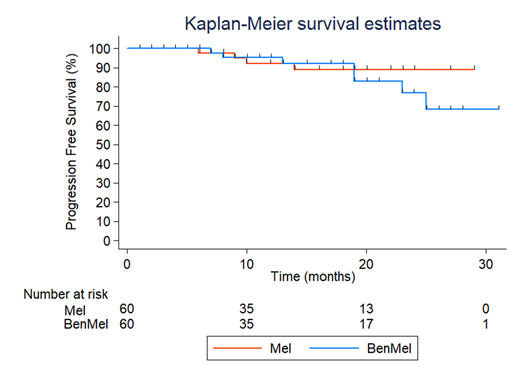Introduction: Consolidation of first-line induction treatment in myeloma (MM) patients (pts) with 200 mg/m2 melphalan chemotherapy (HDCT) and autologous stem cell transplantation (ASCT) was established as standard of care three decades ago. However, definite cure in myeloma patients remains exceptional due to residual disease escaping intensive treatment, and almost all patients will ultimately relapse at earlier or later time points following ASCT. Thus, improving efficacy of HDCT in MM remains an unresolved issue.
Methods: We performed a phase-II randomized trial comparing standard 200 mg/m2 Melphalan (Mel) HDCT to experimental HDCT treatment with 200 mg/m2 bendamustine, a bifunctional alkylating agent, given at days -4 and -3, combined with 200 mg/m2 melphalan split on days -2 and -1 at 100 mg/m2 (BenMel) before ASCT in MM pts. Patients had up to four cycles of first-line induction treatment with bortezomib, lenalidomide and dexamethasone. After ASCT, pts received lenalidomide maintenance treatment for two years. The primary endpoint was to show a 15% improvement of the rate of complete remission (sCR+CR) after HDCT with BenMel compared to Mel alone. MRD assessment from the bone marrow was performed by multiparameter flow cytometry after hematological engraftment following HDCT/ASCT. MRD negativity was defined as clonal plasma cells below 10(-5).
Results: We randomized 120 myeloma pts (60 patients in each arm), with high-risk genetic abnormalities present in 21.3% of the patients. The median age was 63 years (range 35-74). The sCR/CR rate after ASCT before initiation of lenalidomide maintenance treatment was better in the BenMel arm compared to Mel alone (70.0% vs 51.7%; p=.039). The post-ASCT remission rates in detail were sCR 40.0% vs 31.7% (p=.341); CR 30.0% vs 20.0% (p=.205); VGPR 16.7% vs 33.3% (p=.035); and PR 13.3% vs 15.0% (p=.793). MRD negativity assessed in the bone marrow by flow cytometry was observed in 26 (45.6%) of the BenMel treated pts compared to 22 (37.9%) of the Mel pts. Median time until neutrophil engraftment was 11 days after BenMel vs 12 days after Mel (p=.096), and median time until platelet engraftment was 13 days in both arms (p=0.367); all pts had full engraftment of both cell lineages. Prolonged hospitalization duration was seen in BenMel pts (median 19 vs 18 days; p=.006) due to the longer BenMel treatment administration. Fully reversible acute renal insufficiency occurred in three (5%) BenMel pts compared to none of the Mel pts (p=.250). No treatment-related mortality was seen in both groups. ICU admissions were necessary in 3 pts (5%) in the BenMel group (ARDS, septic shock, pulmonary failure), and 2 Mel treated pts (3.3%; due to pulmonary failure and decompensated cardiomyopathy). The PFS rates at 12 months were 95% in BenMel pts and 91% in Mel treated pts (p=.551). OS at 12 months was 96% for both groups (p=.262), and median PFS and OS were not reached in both groups.
Conclusions: Our data confirm that high-dose bendamustine combined with melphalan HDCT before ASCT in MM patients is safe and well tolerated. In particular, bendamustine-associated renal toxicity was manageable and reversible in all patients, and hematopoietic engraftment was comparable to standard melphalan HDCT. HDCT with BenMel improves the sCR/CR rate compared to standard melphalan alone. Thus, BenMel HDCT before ASCT warrants further investigation aiming to improve the long-term survival rates of MM patients, eventually combined with new maintenance strategies in the post-transplant period.
No relevant conflicts of interest to declare.
Author notes
Asterisk with author names denotes non-ASH members.


This feature is available to Subscribers Only
Sign In or Create an Account Close Modal